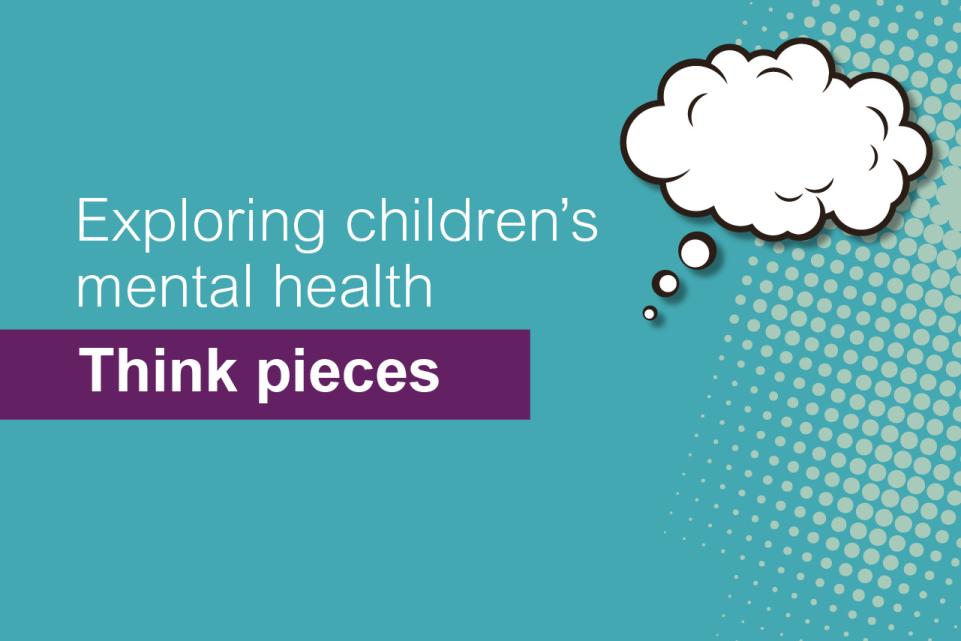Children’s mental health and wellbeing is significant for the children and young people who experience poor mental health, their families and friends that support them, and the services that try their hardest to make a difference in their lives. This page provides an introduction from the Cllr Louise Gittins, Chair of the LGA's Children and Young People Board to the children and young people's mental health think pieces project and an LGA view.
Foreword by Cllr Louise Gittins, Chair of the Local Government Association’s Children and Young People Board
Children’s mental health and wellbeing is significant for the children and young people who experience poor mental health, their families and friends that support them, and the services that try their hardest to make a difference in their lives. For each of the individuals impacted by a child’s mental health, it is likely the most important, most all-consuming issue for them.
Following the pandemic, there have been large increases in children who need support with their mental health, the numbers referred to health services, or the increase of children and young people who could have a probable mental health condition. However, these increases were seen even before the pandemic. Through these statistics, we possibly miss the real-life stories of young people sitting behind them and the struggle they and their families may be facing with long waits or little support.
We also know that mental ill health does not impact all people equally. Some groups are more likely to be negatively impacted as they either do not have the same protective factors, or they have vulnerabilities that may leave them more likely to experience poor mental health. For example, children in care are four times more likely to experience mental health issues than their peers, and young people who identify as LGBT+ are also more likely to experience mental health issues. Children from low-income families are four times more likely than those from the wealthiest households to have a serious mental health difficulty by the time they leave primary school. Rates of mental health problems can be higher for some black and ethnic minority groups than for white people.
The relationships that councils have with partners and stakeholders; including schools, health, police and the voluntary sector are integral for ensuring we can take a collaborative approach to supporting children’s mental health and wellbeing. School can be both the place where children can be supported, their needs are identified and the right interventions are identified. Poor mental health can however have a long term impact on children’s ability to engage with school and education, as we are currently seeing with high numbers of children missing from school.
Despite promising ambitions set out by national government, the approach we are currently taking is unlikely to tackle the rising demand in children and young people’s mental health, meaning not as many young people are going to be able to access the support they need. This is the case from low level mental health and wellbeing needs to acute needs where children and young people need medical support for their mental health, sometimes within a clinical setting.
Councils are seeing increasing numbers of children with the most complex needs requiring support and do not always have the most appropriate provision for these young people. Whilst councils do what they can, this means the outcomes for these children are not always what we want them to be which can be incredibly high cost to the council.
The LGA has a series of asks with regards to children’s mental health on both a local and national level and we always want to improve and refine these to be confident what we are asking for will make the most difference to children and young people, and their families and carers and that councils have the tools they need to improve services.
I am very grateful to the colleagues who have contributed their views to this publication. They have offered intriguing and thought-provoking responses to what we need to see change to support children and young people, and their families and carers. As you read through them, and the LGA’s view, I hope the content supports you to consider your role, your organisations, and how collectively in our day-to-day we can secure a positive future for children and young people.
Cllr Louise Gittins, Chair, LGA Children and Young People Board.
LGA view
The rise of mental health needs among children and young people has been well documented over the past decade with pressures seemingly increasing year on year. While much data and narrative reflect the number of children being referred to health services for mental health support, councils are also seeing more and more young people requiring urgent help.
The underlying causes of children’s poor mental health and wellbeing are complex, but some reasons behind the increase could be apportioned to increased recognition of mental health issues, social isolation and disruptions to home and school routines during the pandemic. We are also seeing the impact of the cost of living on young people which can impact mental health. There is also some emerging evidence that social media pressures are growing for young people, particularly with regard to accessing harmful content. School can be both a protective factor and a cause for poor mental health, particularly when considering stressful periods such as exams.
Councils have a range of responsibilities in relation to children and young people’s mental health. They also have a key leadership and delivery role in promoting good mental health and wellbeing in local communities. For example, through system-wide local leadership on health and wellbeing boards, integrated care partnerships and place-based care and support systems. Councils also have statutory duties and powers for children and young people, those in care and under the Mental Health Act. Having a strong partnership with schools is also essential, providing a strategic oversight role in co-ordinating different partners (mental health specialists but also youth groups and the voluntary sector) to support schools, children and young people, as well as using their expertise to facilitate conversations locally and bringing schools nurses, educational psychologists and others together.
The erosion of budgets for early intervention and prevention services, the stress on public health budgets, despite some small increases in the past year, and pressures on other services such as green space, housing and communities has impacted the ability of councils to create happy, healthy environments that support children and young people’s mental health. Many councils have high quality services for children and young people’s mental health but these are under pressure with rising demand and workforce pressures. But, some children and young people will require a clinical intervention. Too often the system considers what the medical response is to children and young people rather than the social factors that may be contributing to their mental health needs. This means the system sometimes does not have the right response to children and young people with mental health needs and looks to clinical treatments rather than holistic support.
The current system is constructed to incentivise behaviours that prioritise specialist and complex treatments at the expense of earlier intervention and prevention. There remains inadequate data collected on the outcomes of children and young people with health and commissioned services measured against access to specialist treatments. Strong and robust partnerships can be part of the jigsaw that improves local systems to deliver support for children and young people.
Local health services have gone through significant change over the past decade with a move from smaller footprints through CCGs to now larger bodies; Integrated Care Systems, working through integrated care boards and integrated care partnerships. Although this means local arrangements can be complex with the possibility that different services are available to children living in slightly different post codes, the move to a new model provides an opportunity for children’s mental health to move up the priority agenda. Furthermore, the LGA maintains that local decision making is key. Local areas know their communities best, what services are available and what the needs of children and young people are.
There appeared to be light at the end of the tunnel with the announcement of a ten year action plan into mental health. This would have provided much-needed focus on mental health, a clear focus on children and the bringing together of different government departments. The replacement of this plan with the major conditions strategy where mental health and children and young people are one small part has been disappointing and leaves a gap in national direction for an increasingly concerning issue. Research commissioned by the LGA has shown that although there have been some positive ambitions in government policies over the past ten years, there is a lack of national direction and the ambitions haven’t been sufficient to keep pace with the mental health needs of children and young people.
By bringing together a range of different stakeholders, people with lived experience, researchers, and experts in this field, these think pieces provide an opportunity to think differently about what children and young people need to live well.
These pieces have been developed independently from the LGA, providing an opportunity for the LGA itself to reflect on what it wants to see in terms of mental health reform, and what councils can do to help create a society that reduces the need for young people and families to turn to acute health services for mental health support. These are also intended to be used by partners, policy makers and government to promote different ways of thinking about these issues.
These think pieces consider four different questions.
- What are the conditions for ensuring good mental health and wellbeing in children, young people and families?
- What can we do to develop a mental health system that works for children?
- How can we support all children, young people and families?
- How do we support children with the most acute needs?
Despite some improvements in support for children and young people and their mental health, what we are doing now is not sufficient to stem the increasing needs of children and young people. The LGA would like a series of changes made to improve children and young people’s mental health and wellbeing and the system that supports them. This includes, expanding mental health support teams in schools to full country coverage, investing in youth services and other forms of early intervention and prevention support, introducing counsellors in all state secondary schools (for example, LA maintained, academies and free schools), building early support hubs in each local community, developing the specialist mental health workforce and supporting all staff to recognise that mental health is ‘everyone’s business’. The list goes on.
It is however clear that wider changes to society need to be considered to create better conditions for children and young people to grow up in and councils through public health, as strategic local influencers, and employers and through their support to schools, can be key in stimulating these changes.
Following the publication of all the think pieces, the LGA will revisit its proposals for what needs to change for children and young people’s mental health and how we can ensure a positive future for all children.




